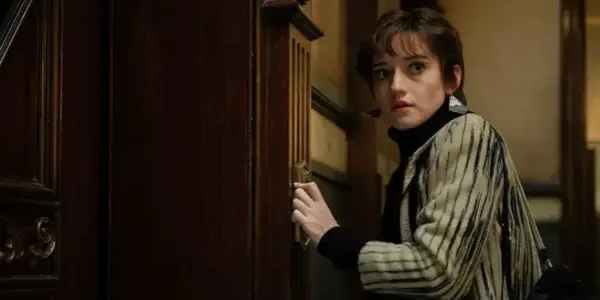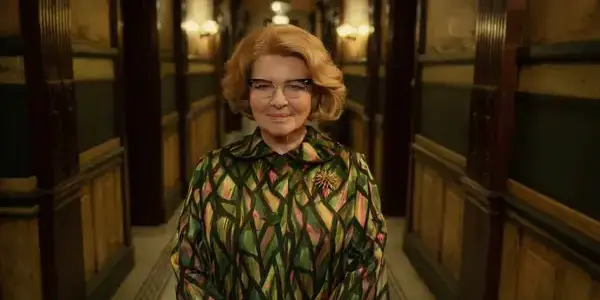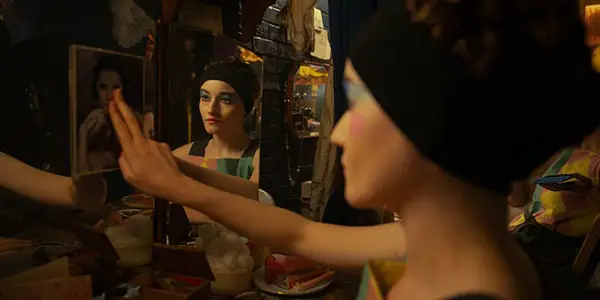APARTMENT 7A: Subletting A Classic, No Remodeling Allowed

Payton McCarty-Simas is a freelance writer and artist based in…
It’s not a spoiler to reveal how Apartment 7A–– the latest in a fitful line of films that fail to live up to Rosemary’s Baby–– ends. The final moments, partially shoved midway through the credits like an embarrassing secret, come in media res, at the precise moment when Terry Gionoffrio’s story ends and Rosemary Woodhouse’s begins, on the night she becomes the target of the Satanic cult that impregnates her with the Devil’s son in Polanski’s era-defining feminist classic. This strangely overacted, heavy-handed groaner of an ending (you can almost see the script: “Minnie glances at Roman and gives him a significant smile…”), is noticeably out of joint with the rest of the film. It also makes Relic director Natalie Erika James’ riff on Polanski’s seminal maternal nightmare the second self-consciously “feminist” horror prequel this year to fall into the seductive trap of IP prequelitis for women directors: Where at once these kinds of projects offer women the chance to intervene in foundational cinematic narratives, lending them a perspective previously overlooked, it apparently comes at the high premium of selling out in glaringly obvious, silly and undermining ways.

Unfortunately, where Arkasha Stevenson’s The First Omen had something innovative, biting, and propulsive to offer as it borrowed liberally from old classics, at its best, Apartment 7A is a tale as old as the Bramford, with far fewer secrets hiding inside.
Whose Apartment Is It Anyway?
Where some classic films offer few opportunities for adaptation (recall Charlton Heston mandating that his character be killed off in a failed bid to nip the Planet of the Apes franchise in the bud), the premise of Apartment 7A is conveniently obvious, even promising, within the source material: In Ira Levin’s novel and Polanski’s film, Minnie and Roman Castevet take in a young woman, Terry Gionoffrio, off the street and into their apartment (7A) before choosing Rosemary instead, helping their young charge out before impregnating her with Satan’s spawn. When Terry discovers their plot, she kills herself by jumping out their apartment window, leaving the old satanists in need of new blood. Besides her good looks, her Italian name, and her suicide, the details of Terry’s life are left conveniently hazy, giving screenwriters plenty of room to maneuver.

So it’s odd, then, that James’ team has altered the basic premise of the story: In this version, the Castevets have two apartments in this coveted, expensive building: theirs, and a whole second unit to offer prospective foundlings. It’s now this apartment (7A), not Minnie and Roman’s, that abuts Rosemary’s, a detail that breaks the two films’ continuity almost immediately–– the Castevets’ living directly next to the Woodhouse residence is a foundational premise that no longer applies in this version (unless they moved into their spare space after Terry’s death in order to invade Rosemary’s home, which makes no sense). What’s more, this choice brings Terry closer to Rosemary’s experience, adding unnecessary similarities to the narratives rather than playing off the tantalizing question, how might Minnie and Roman be as roommates?
Putting on a Show
This massive retcon aside, though, the film’s problem is less one of continuity and more one of bloat. This version of Terry (Julia Garner) is a down-on-her-luck dancer with a yearning for the spotlight, a choice that combines Rosemary and Guy’s narratives into one character. After her foot breaks in an embarrassing accident on stage, she becomes addicted to pills. She encounters the Castevets (Kevin McNally and a venomous Dianne Wiest, holding her own against an all-out impression of Ruth Gordon) on an especially dire evening, vomiting on the street in pursuit of an unsavory director, a smooth operator named Alan Marchand, (a bland Jim Sturgess) with a hot musical revival debuting on Broadway. The show, we soon learn, was penned by one Adrean Mercato, Roman’s satanist father in the original (at one point in the ‘68 film, the octogenarian tells Guy his father was a producer, though we’re led to believe this is a lie). After the Castevets take her in, they set up a date with the director, during which–– she believes–– he drugs and rapes her in a relatively interesting fantasy dance sequence meant to parallel Rosemary’s own ritual assault. Soon, Terry realizes the true scope of her violation when she discovers her infernal pregnancy.

While the combination of Guy and Rosemary’s plots here ostensibly allows Terry more agency in her own story (it should be noted on this score that the period piece element of this film is largely window dressing: Terry, a hometown girl from rural Nebraska, seems unusually comfortable proposing an abortion as a valid option to an elderly couple in 1965), it also comes with the unfortunate side effect of drawing power and time away from the pregnancy plot itself. Where Rosemary’s Baby’s treatment of a woman’s right to choose feels as urgent now as it did in 1968, this film can’t decide where to focus its energy, from the Metropolis-style musical and the Showgirls-style machinations amongst its cast (there’s a lot of 2018 Suspiria here, alongside Last Night in Soho), to spoon-feeding an excess of exposition for unseasoned viewers, to, lastly, Terry’s struggle with her bodily autonomy.
Throwing the Baby Out with the Bathwater
The film manages to go down smoothly and get in a few good jumps even as these elements battle for primacy. The acting is solid across the board, though only Dianne Wiest has a chance to truly showcase her performance; some of the visuals are tantalizing, particularly the Devil himself; the costumes are fabulous; in a few scenes, Jones’ direction successfully turns a quotidian moment into a psychological minefield in the span of a single frame. But the plots nevertheless can’t reconcile themselves and each element loses potency in the process, like one of Minnie’s vitamin drinks left out to sit too long. While the oddball musical is one of the film’s visual pleasures, it doesn’t serve much of a purpose beyond a generic, abstract motivation for Terry’s deal with the devil–– she never coheres into a flesh and blood character, dulling the impact of her plight and Garner’s performance; the exposition, too, is continuous and openly distracting, miring the production in rehashing the original and delivering stale reveals; the worst of which comes in the form of a cringe-worthy scene with a nun in a church that, strangely, takes its cues from The Omen in a fashion The First Omen (mostly) managed to avoid.

Indeed, The First Omen’s violently intimate scenes of pregnancy’s physical and psychological discomfort, its dislocation and general goopiness, make it a much better homage to Levin’s novel. Here, it isn’t until startlingly late in the film that Terry decides to actively confront her impending motherhood–– a shame in light of the fact that some of the film’s most potent imagery occurs here. In one particularly striking scene, for example, Terry envisions a mangled baby corpse thumping around in her dirty laundry. In another, that insidious right-wing saw, “fetal personhood,” takes on a whole new meaning as baby Beelzebub develops the violent power of telekinesis from the womb. By packing in a more “active” motivation for this woman, rather than allowing her the space for a personal experience either as a working woman or a prospective mother, it would seem, Jones’ film has largely thrown the baby out with the bathwater.
Conclusion
While Jones’ film far exceeds the 1978 sequel and the 2014 remake of Rosemary’s Baby, it neither lives up to the suspense or the politics of the original, relying heavily on unsubtle cinematography (a surfeit of shallow focus and rote dissolves) and dream sequences to rehash its ideas. Similarly, while interesting, the ending feels less like a novel intervention and more like a product of current horror trends. Apartment 7A offers less while trying to add more.
Apartment 7A is streaming on Paramount+.
https://www.youtube.com/watch?reload=9&v=Kj2GqMvhbNM
Does content like this matter to you?
Become a Member and support film journalism. Unlock access to all of Film Inquiry`s great articles. Join a community of like-minded readers who are passionate about cinema - get access to our private members Network, give back to independent filmmakers, and more.
Payton McCarty-Simas is a freelance writer and artist based in New York City. They grew up in Massachusetts devouring Stephen King novels, Edgar Allan Poe stories, and Scooby Doo on VHS. Payton holds a masters degree in film and media studies from Columbia University and her work focuses on horror film, psychedelia, and the occult in particular. Their first book, One Step Short of Crazy: National Treasure and the Landscape of American Conspiracy Culture, is due for release in November.













